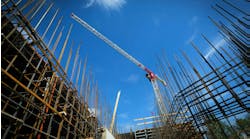As the global market continues to be pressured from recessions, increased supply chain complexity brought by geopolitical conflicts, material price increases and labor shortages, a new layer of uncertainty is making its way throughout the construction and engineering (C&E) industry.
There is huge potential for those looking to adapt and become more resilient explains Kenny Ingram, vice president of construction & engineering, and Chris Knight, global industry director of construction & engineering at IFS. With a combined 60+ years of industry expertise, they analyze key market data and identify three areas of change that will help C&E organizations navigate the turbulent market dynamic.
1. The rise of the industrialized construction model — becoming the next-gen construction company
Increasingly we are seeing the industrialization of construction processes, in fact, by 2025, 30% of companies will change their construction processes to an industrialized construction model. However, we also see that the long-standing challenges of improving productivity (while reducing cost and waste) remain. Plenty of companies have struggled to successfully evolve their operating model use — for example, modular construction. So, how can they transition more successfully?
A recent McKinsey report commented on low productivity in the industry and produced a comparison to show that if the construction industry were able to keep pace with other industries like manufacturing, it could reach a value of $1.6 trillion per year. The industry’s traditional challenges have been amplified by the global financial pressures and disruptions caused by inflation, parts and material availability and transport challenges, as well as price increases for materials, and equipment. All of which are heightened by labor costs and shortages brought on by an aging and retiring workforce and subsequent widening skills gap—currently estimated to exceed a million workers by 2025.
But through watching other industries and their experiences, the construction industry is evolving to a new model of working. For example:
- Standardization and platforms – Assemblies of parts/components are gathered off site to increase quality when brought on site. As such, this reduces time and wastage that would otherwise require people on site to work and pay.
- Design for manufacturing and site assembly – This approach looks to find the commonality between the systems within buildings across many different sectors, to then design standard kits of parts that can be put together to form the structure of just about any building.
- Digital design (BIM becomes critical) – Be able to take a design, cross-discipline as a model and ensure that “getting it right the first time” is possible by identifying where there are clashes of components or design issues.
- Increased emphasis on structured supply chain processes (e.g. part numbering and inventory management) – Taking a more “work package structure” approach enables greater control and management of many aspects of material, subcontract, labor, and equipment.
Companies will have to transition to industrialized construction processes to drive performance improvements and succeed in the future.
In simple terms, companies must be able to execute a hybrid model combining traditional business processes with additional processes, such as integrating BIM model data into all stages of the asset lifecycle, supporting construction site-based structured work packages, kitting and assembly, standardization, part numbering and more disciplined supply chain, logistics and inventory control, and manufacturing for some. It is likely that the first step for many will be to review their business system landscape and to simplify/consider whether they need to replace, renew, or reuse some of their existing systems with solutions that can support this new hybrid model.
2. It’s time to put planning at the heart of project operations
A recent article from ENR (Engineering News Record) stated that new construction projects will be flat in 2023, so growth is going to be a challenge. In addition, there is a headwind of challenges facing most global economies with high inflation and a recession predicted to hit many countries. Against this backdrop, companies have recognized that they will need to improve company and project financial control processes and systems. The need to report on a project’s financial status and accurately predict the outcome of a project has never been more vital. Now, 20% of companies, will execute plans within the next four years to have more robust, timely, and accurate financial control and governance processes/systems.
Yet many companies fail to realize that their current mix of disparate processes and systems with poor or no integration are compounding the reliance on an excessive use of Excel spreadsheets to produce financial project control information. Running project and financials on Excel has been proven to hinder performance and prevent companies from meeting their key objective of delivering projects on time, on budget, and to a high standard.
In the process of determining a solution that will tackle this issue, we had to first review the current situation. In the next two sections, we analyze a typical scenario and highlight some key findings.
At present the most typical situation is one where financial accounting systems exist but have limited integration with the systems that process the cost and revenue transactions that impact the project. These are procurement (materials, services, equipment rental, and plant hire), sub-contract packages, labor costs from payroll, time recording and expenses, and occasionally manufacturing costs, as companies transition to more industrialized construction methods. Without an integrated approach, the actual costs and revenue transactions are processed through manual journals, which are manually entered into the finance system. These are very slow and error prone, and they do not allow for any meaningful or real-time drill down analysis.
Compounding this is that commercial and project budgeting and forecasting processes are often managed using a combination of non-integrated point solutions and Excel spreadsheets. Impacted by the lack of suitable technology are activities such as bidding and estimating, project budget creation, risk and opportunity management, sales and sub contract management, the application for payment and certification, project and contract change management (variations), insurances and indemnities, accruals, project and company cash management/forecasting, periodic project cost control, progress and earned value management, and project financial forecasting. All of these can in isolation — as well as in a group — have a negative impact a project outcome.
With this backdrop, we are seeing a strong trend emerging. Companies now want all the above processes and associated data to come from one complete project financial control solution that provides reliable, accurate, timely, trusted project financial status and reporting and more accurate project outcome forecasting. Companies now more than ever understand that they must make this transition to improve their project financial performance, reduce project and business risk, and make more informed business decisions.
3. Simplify and standardize: move project processes to a single, operational platform
We have established that there is increased urgency for companies to improve business performance. For C&E companies, this starts with improvements in project performance and project margins, productivity, quality, and sustainability, while at the same time reducing the total asset life-cycle cost and financial risk.
Embedded in this performance goal is the need to deliver projects using standard repeatable processes and achieve predictable, repeatable results. We can expect to see a quarter of companies move to simplify and standardize their project processes with a single operational platform
To achieve this, business processes and systems that support these processes need to be challenged, reviewed, and improved to shift toward a lean construction model. These process shortcomings are made worse by a complex and ineffective business systems landscape where data does not flow, and users rely on Excel to close the gap in data analysis and functionality — something we already established in the first prediction.
Addressing this must be seen as the first step for companies if they are contemplating the roll out of world class best practices at the heart of which sit repeatable and standardized processes and reliable and output focused data structures which have longevity across multiple projects.
Having the right technology is now acknowledged as a vital foundation to achieving improved project and business performance. ERP has been hailed as the solution for many years but for most companies it has failed to deliver. Too often ERP is seen as an accounting software solution, with everything else requiring a specialized system.
This trend is thankfully starting to change as the need for end-to-end integration and visibility increases. Construction and industry specific ERP solutions will allow back-office finance and human capital management solutions to be satisfied as well as the owners of more operational processes, such as estimating, contract management, project management, risk management, and construction site execution processes. One integrated ERP platform is now accepted as the basis to allow companies to adopt standard repeatable processes that positively impact and improve project performance.
The realization for the need to join up processes and data across front and back office in large construction companies does not mean rip and replace with lengthy and costly investment. ERP comes as a composable technology or what is termed a common operational solution platform (OSP) which can co-exist with an existing back-office solution. This will also allow operational standardization and improved project delivery performance to be realized at speed.
Resilience is key in this new reality
Whether you are a general contractor, specialty contractor, EPC, or required to perform a specialized function, the long-running challenges of an aging workforce, increasing skills gap, poor profit margins, and low productivity have been manageable until now.
For those that haven’t incorporated the latest technology innovations (such as BIM, drones, IoT, robotics, and automated machinery) into their transformation journey, they simply must evolve their thinking into action.
Resilience is what has kept the industry moving, and it is what will evolve companies into industry leaders with a more lean, profitable, and technological operating model that will not only weather the uncertain times ahead, but also provide a more reliable platform for success.
Kenny Ingram is vice president of construction & engineering engineering at IFS. He can be reached at https://uk.linkedin.com/in/kenny-ingram-6b22167. Chris Knight is the global industry director of construction & engineering at IFS. He can be reached at https://www.linkedin.com/in/christknight/.




